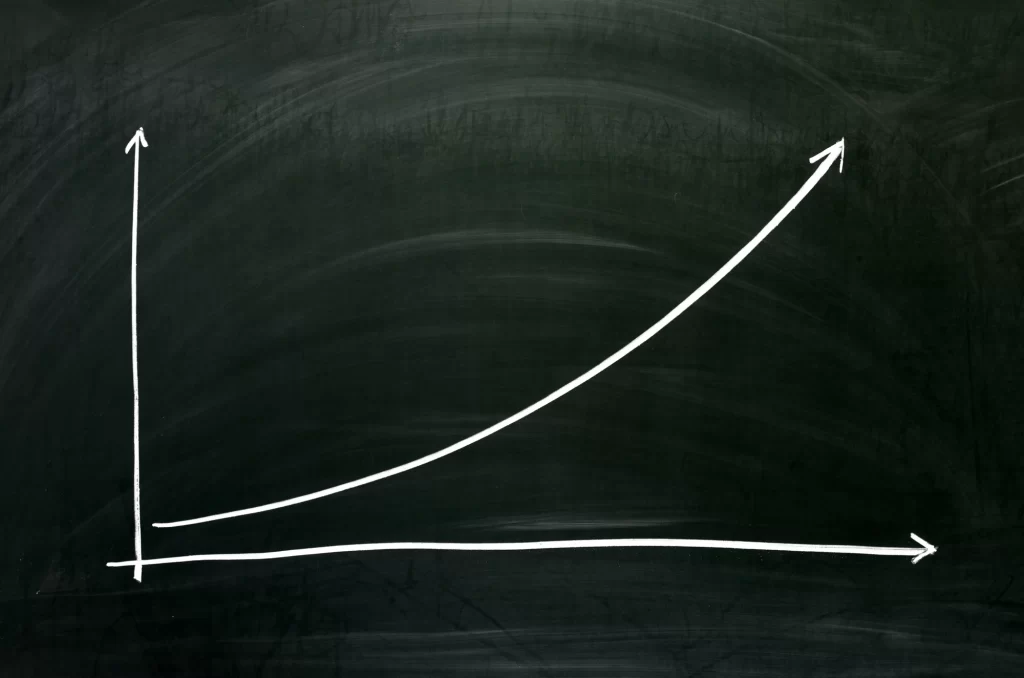
This table will change the way you think about your money.
You’re probably curious about investing or have been pointed toward learning about it. After all, you’re here reading this, aren’t you? Yes, you’ve probably heard that investing is super important. While that’s true, you might not fully understand why.
There’s a difference between knowing that long-term investing grows your money over time and understanding its real-world impact.
That’s because of how our brains work. So, it’s time to rewire your mind to think differently and unlock your wealth-building potential.
Linear thinking creates limitations
Most of what we experience in the world around us happens linearly. In other words, things happen step-by-step, predictably, like a straight line. If walking to the grocery store takes a half hour, walking home will take about the same time. You count things one at a time. You read directions step-by-step.
Our brains gravitate toward linear thinking because that’s how we generally live our lives. There’s nothing wrong with that, but it can create blindspots to concepts that don’t play by those rules. Compounding is one of those tricky subjects that the brain needs help understanding.
Suppose you’re given the option of having $1 million today or a single penny that doubles daily for one month. Which would you choose? A lot of people would pick the million dollars. After all, if you chose the other option, you’d only have just over $10,000 three weeks into the month.
But that $10,000 will grow to more than $5 million over those last nine days. Compounding becomes more powerful the longer the math plays out, a concept that many people find difficult to grasp fully.
The most important table you’ll ever see
Compounding plays out the same way when you’re investing. The S&P 500, an index of 500 of America’s largest publicly traded corporations, has historically returned an average of 10% annually. It’s higher or lower in most years, but that’s its long-term average.
A 10% return may not wow you, just like a penny won’t at first. However, given enough time, compounding turns this into a force of nature. Invest $10,000 one time, and don’t add another penny. Here is what you’ll have as your money compounds 10% annually over time:
| YEARS | AMOUNT |
|---|---|
| 5 | $16,105 |
| 10 | $25,937 |
| 15 | $41,772 |
| 20 | $67,275 |
| 25 | $108,347 |
| 30 | $174,494 |
| 35 | $281,024 |
| 40 | $452,953 |
| 45 | $728,905 |
| 50 | $1,173,909 |
CALCULATIONS BY AUTHOR.
Did you know that the average nest egg in America is just $87,000? You could accomplish that by making a one-time investment at age 40, working until 65, and never putting another thought into it. That’s not enough to retire on, but it shows just how low the bar is to be average.
Do that at age 20 instead, and you’ll be a millionaire on your 70th birthday without investing another penny for most of your life.
Turn ideas into action
The point of this article is not to convince 20-year-olds to do the bare minimum for their financial future. It’s to show you how powerful compounding can be if you put it to work for you. Consider adding to your monthly investments instead of a lump sum, even if it’s only $50.
Invest $50 per month your whole working life from 20 to 70, and you’ll still have $730,000 when all is said and done — no lump sum required! Are you getting a late start? Invest $500 from age 40 to 65, and you’ll clear $600,000. The math is based on your age and where you are in life in terms of how much you can save.
It’s never too late.
Ultimately, having a meaningful nest egg only requires effort and knowing how obtainable it is. Don’t underestimate how much getting started and sticking with investing can brighten your financial future.
